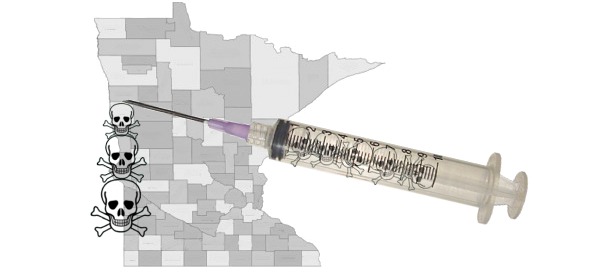Diseases
Modern Medicine’s Fatal Flaw Revealed in Research
 Recent research findings document a major conflict: The same substance can be either harmful or beneficial, so the substance is not the issue. Medicine is focused on symptoms, not disease.
Recent research findings document a major conflict: The same substance can be either harmful or beneficial, so the substance is not the issue. Medicine is focused on symptoms, not disease.
by Heidi Stevenson
A new study has documented that certain bits of protein called ß-amyloid are heroes in multiple sclerosis because they’re associated with reversing paralysis.
Other studies have shown that ß-amyloid peptides are villains in Alzheimer’s, so they’re called abnormal, even labeled as deviant, and have been the primary focus of Alzheimer’s research.
ß-amyloid is a Hero?
ß-amyloid is a Villain?
How can that be? Is ß-amyloid friend or foe, hero or villain? Modern medicine’s approach demands that it be one or the other, but obviously, that makes no sense.
There is something inherently flawed deep in the foundation of modern medicine, and it’s clearly revealed with this apparent discrepancy. That flaw strikes at the cornerstone of medicine’s structure.
In mainstream medicine, symptoms are seen as the disease itself. Changes that precede disease are redefined as new diseases, such as osteopenia (pre-osteoporosis) or high cholesterol (pre-heart disease). So, what gets treated is the symptoms, not the disease.
In the search for disease causes, regression to smaller and smaller particles has become the focus. First, it was organs. Now it’s particles smaller than cells, even smaller than proteins.
And now, we’re seeing where that leads: a stone wall.
The Villain of Alzheimer’s Is the Hero of Multiple Sclerosis.
Sticky plaques formed of protein bits, ß-amyloid, are found in the brains of people with Alzheimer’s disease. So these plaques have been treated as if they were Alzheimer’s itself, and research has been trying to find ways to prevent ß-amyloid plaques from forming or to remove them. Indeed, ß-amyloid and anything associated with it has been considered abnormal, literally deviant—something that doesn’t belong in the brain and must be destroyed.
Now, though, this same substance has been found to reverse paralysis in mice with multiple sclerosis. Not only that, this reviled protein bit also has anti-inflammatory effects. Oops!
So, what is this mysterious ß-amyloid? How can medicine deal with it unless they know which it is? How can it cause one disease and cure another? Or … are these the wrong questions?
Asking the Wrong Question
Asking if ß-amyloid is friend or foe is like asking if air is friend or foe. Every minute of every day for our entire lives, we breathe it in. We cannot survive without it. Yet, in tornadoes, air can become deadly. High winds can blow a piece of straw through a tree or pick someone up and dash his brains out.
Getting rid of air to prevent tornadoes is obviously crazy, because we’d all die from lack of it. That, though, is the medical system’s approach to health. They find that something is indicative of disease, such as cholesterol or high blood pressure—or in the case of Alzheimer’s, ß-amyloid—and the approach is immediately to attack it, destroy it, without consideration for why it’s there or what benefits it might be producing.
Obviously, it’s nonsense to label air as friend or foe. And it’s equally obvious that labeling ß-amyloid the same way is also nonsense.
ß-amyloid is made by the body because it’s necessary for life, though little is known about its function—probably because so much effort has instead gone into finding ways of destroying it in Alzheimer’s. Obviously, it can point out something wrong. But when medicine tries to treat it as if it’s the issue, that either destroying or increasing ß-amyloid plaques can produce health, is utter nonsense.
Yet that is precisely how modern medicine deals with virtually everything. Something found to be good or bad in a context is accordingly defined as good or bad. Research then proceeds to find ways to artificially increase or destroy the substance or symptom.
Cholesterol is an example of the same process. It’s a substance made by the body. It’s absolutely necessary for health. Yet, in some contexts, cholesterol can indicate that something is wrong. It does not then follow that preventing its formation will lead to health. Far from it! But modern medicine cannot see that. As a result, statins are routinely prescribed and even suggested for everyone over the age of 50—in spite of well-documented harms, including muscle pain, diabetes, and memory loss.
Modern medicine seems to be incapable of viewing the human (or animal) body as a finely-tuned organism in which all the parts, whether large, as in organs, or infinitesimally small, as in ß-amyloid or cholesterol, are needed and are never, in and of themselves, heroes or villains. The status of any of them is a symptom, whether indicative of health or illness.
Symptoms are not causes. Symptoms are not diseases. Eliminating them does not remove disease, and may exacerabate it.
As long as medicine insists on this absurd idea, then it’s headed in the wrong direction. For every drug or treatment used to counteract a disease, there seem to be more and more adverse effects, and these negative effects generally prove to do more harm than benefit. That’s why mammograms are now known to do more harm than good. It’s why drugs have adverse effects that usually end up producing more harm than good. It’s why spinal surgeries so often result in devastating damage to patients.
Recent research findings document that the same substance can be seen as either harmful or beneficial, depending on context. Surely medical science researchers can figure out that they’ve run into a paradox and step back to figure out where they’ve gone wrong.
Until they do, medical science is best referred to as junk or pseudo science. When the basic premises are wrong, the results, including medical treatments, more often than not are bound to be ineffective and harmful.
Sources:
- Reversal of Paralysis and Reduced Inflammation from Peripheral Administration of β-Amyloid in TH1 and TH17 Versions of Experimental Autoimmune Encephalomyelitis DOI: 10.1126/scitranslmed.3004145
- Reviled Substance Involved in Alzheimer’s Can Reverse Paralysis in Mice With Multiple Sclerosis
- Researchers discover reviled substance involved in Alzheimer’s can reverse paralysis in mice with multiple sclerosis
- Alzheimer’s Is Diabetes of the Brain: Diet & Vaccination Connections
- ARBs May Curb Amyloid Deposition in the Brain
Tagged beta amyloid plaques, beta-amyloid, big pharma, conventional medicine, disease symptoms, junk science, medicine fatal flaw, medicine’s fatal flaw, multiple sclerosis, pharmaceutical drugs, pharmaceuticals, pseudo-science, pseudoscience, ß-amyloid, ß-amyloid alzheimer’s, ß-amyloid bad, ß-amyloid good, ß-amyloid multiple sclerosis, ß-amyloid paralysis, symptoms, symptoms are not disease, symptoms diseases













